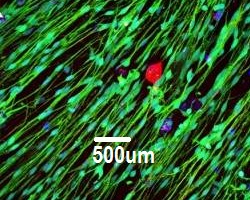TAP Biosystems is collaborating with scientists at the Open University (OU), in Milton Keynes, UK to produce robust 3D human central nervous system (CNS) tissue models for use in drug discovery and pre-clinical testing.

In the 3D matrix, aligned glial cells (green) support neuronal growth (red)
The collaboration will run for three years and focus on technology to generate and manufacture advanced 3D CNS tissue models.
Using TAP’s Raft technology, glial cells and neurons will be made into gel-based tissues. Cells are seeded in collagen gel in a rectangular mould and tethered at each end. The cells contract the collagen and become highly aligned, mimicking the cellular arrangement of living CNS tissue.
These tissue models could be used to monitor the responses of glial cells and neurons to simulated damage, and could have applications in pre-clinical screening for disorders such as Alzheimer’s disease.
Dr James Phillips, lecturer in health sciences at the Open University, explained: “Astrocytes are CNS glial cells that normally support neuronal activity, but they change behaviour following damage and can inhibit regeneration.
“2D cell cultures of astrocytes and neurons don’t behave as they do in a living organism, and this can limit their usefulness.
“The cellular alignment created using Raft allows the other types of cells to organise themselves as they would in a natural environment. This means we can simulate the interaction between glial cells and regenerating neurons after CNS injury and monitor both cell types continuously”.
